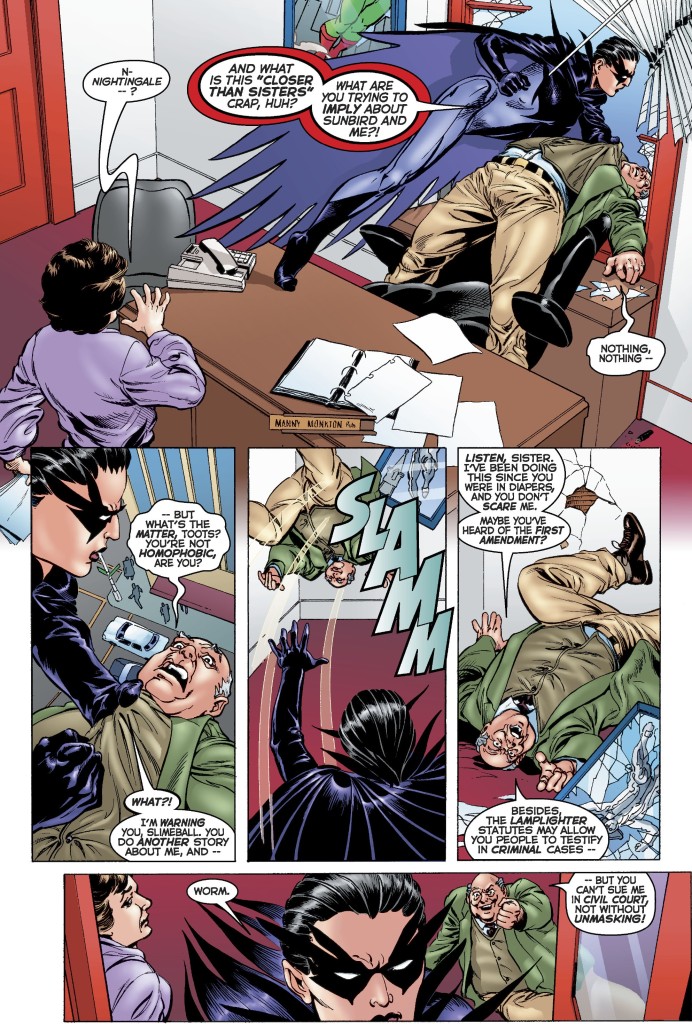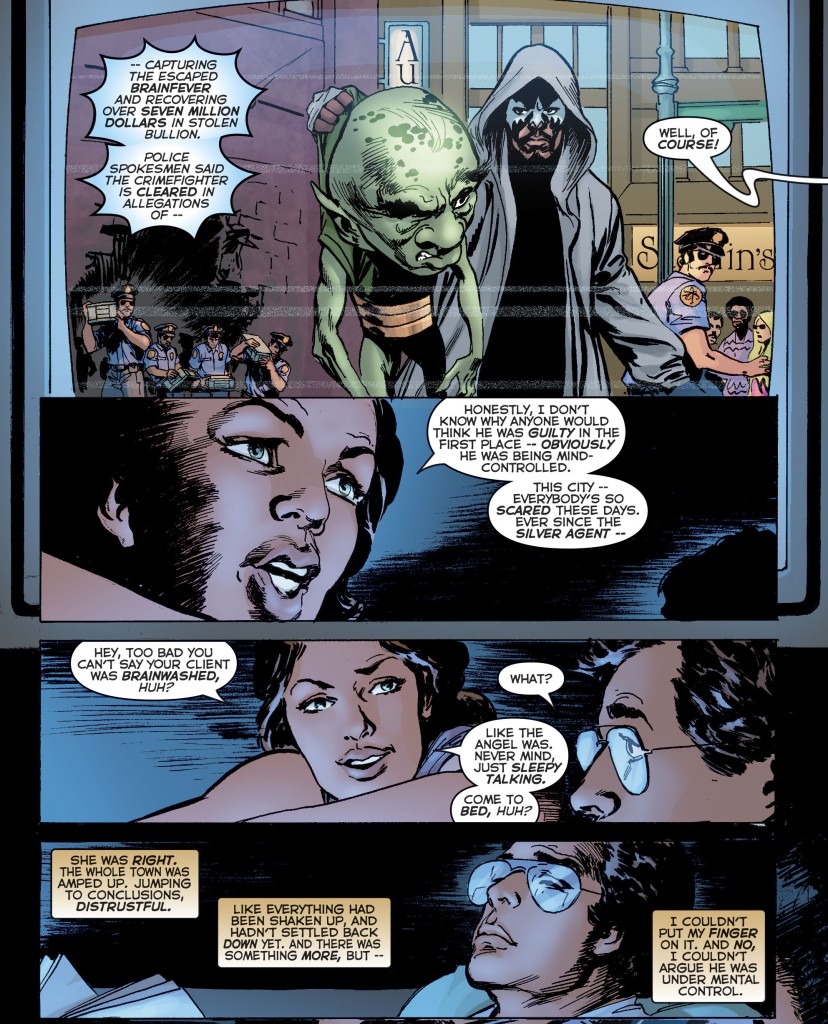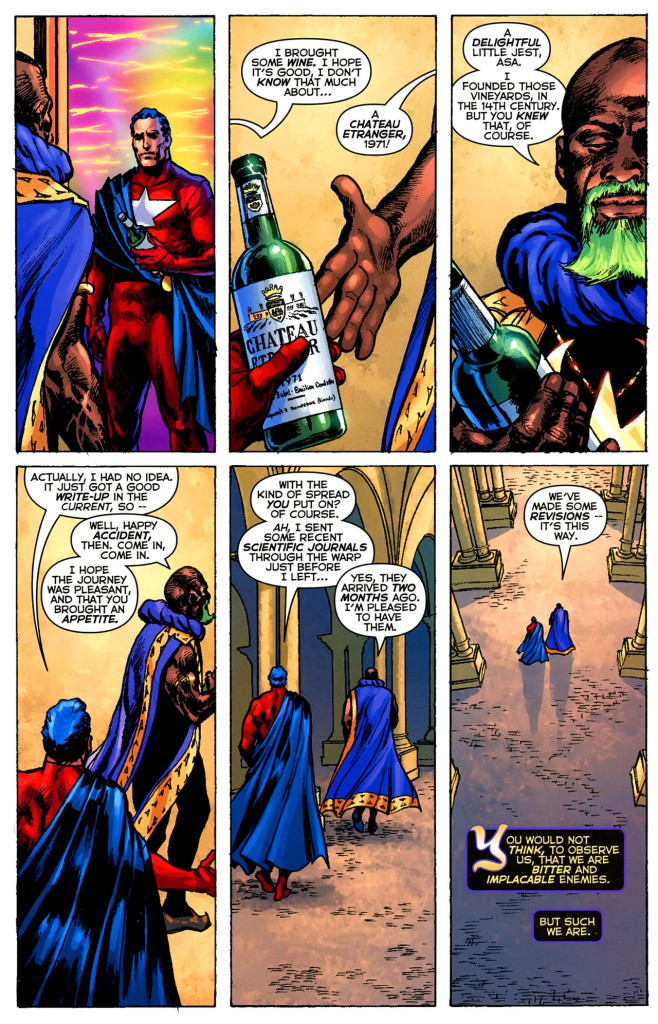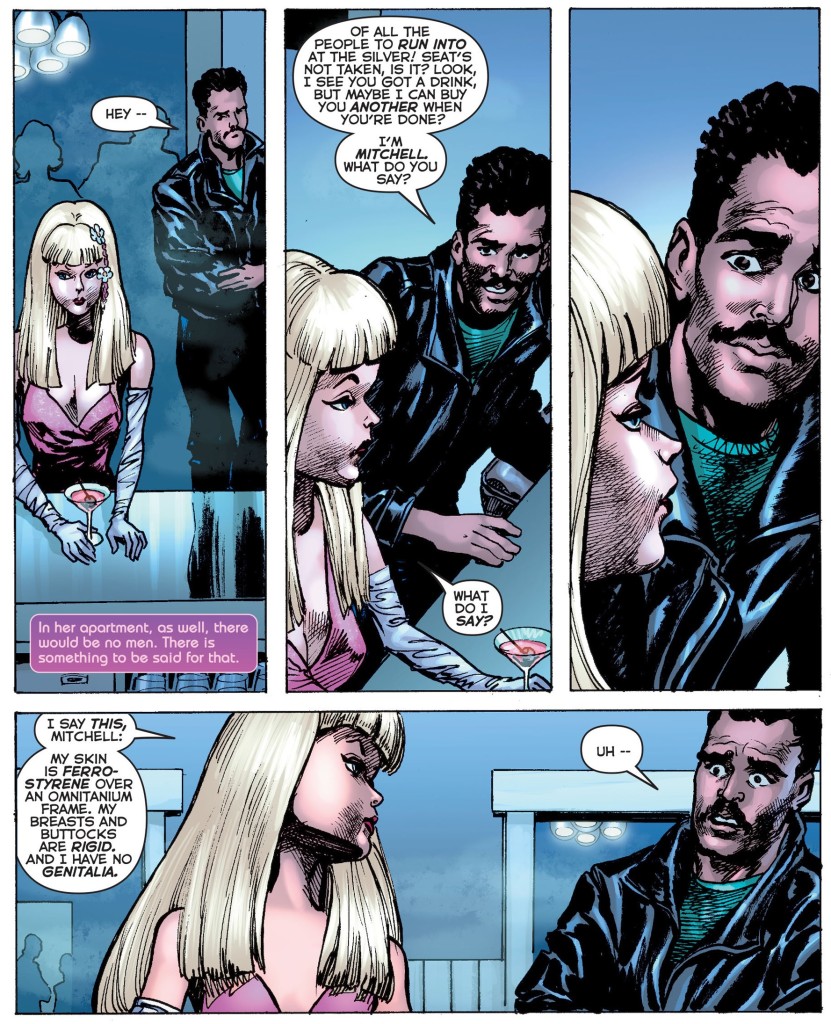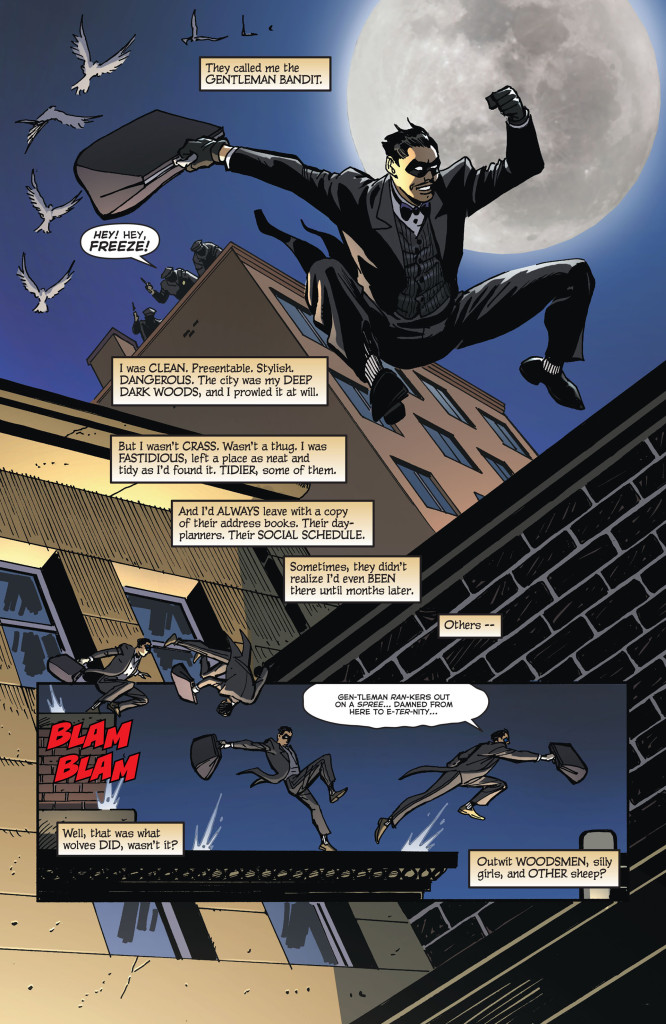If you read the last post, you know what’s going on. Here are another five brilliant issues of Astro City:
‘Where the Action Is’
(Astro City (v2) #21)
Another blatantly ‘meta’ issue, albeit with a more satirical bent. ‘Where the Action Is’ is told from the perspective of Sally Twinings, writer at Bulldog Comics, a local comic book company specialized in non-fiction superhero series, licensed to publish the exploits of ‘real world’ heroes. The thing is that the publisher, Manny Monkton, likes to play fast and loose with the truth, adding inaccurate, sensationalist elements to the stories in the name of spectacle and excitement, much to the chagrin of the actual heroes…
Again, you can see in this tale a further exploration of the tension between superhero fiction and realism, whether you interpret Manny as a metaphor for creativity and entertainment that doesn’t want to be held back by realism or whether you (like Geoff Klock) see him as a symbol of the lack of respect for superheroes’ history manifested by revisionist authors, so that the heroes’ complaints about slander come across like ‘characters taking revenge for literary misprision.’ It’s also a tribute to the medium’s long line of eccentric editors and publishers – all those hucksters who could be cynical and manipulative, but who also imbued their staff with enthusiasm and helped fill the readers with joy.
Aside from these many layers, ‘Where the Action Is’ is also one of Astro City’s funniest tales, leading up to a hilarious punchline near the end.
‘Knock Wood’
(Astro City: Local Heroes #4)
A fascinating look at Astro City’s jurisprudence, ‘Knock Wood’ shows us the first time a lawyer decided to apply the standards of superhuman logic to ordinary crime. I’m a sucker for this kind of stuff – just beginning to imagine how the legal system would cope with a superhero universe is a field so rich with possibilities that it has inspired many extremely cool comics (Powers Annual #1, Top 10: Season Two Special, Dan Slott’s run on She-Hulk), but ‘Knock Wood’ also benefits from Kurt Busiek’s ability to quickly conjure up a fully formed character in a lived-in corner of the world. On the obligatory metatextual side, the fact that the story takes place in the 1970s is clearly meant to reflect the end of the Silver Age (represented by the recent death of the Silver Agent), tying the growing cynicism about superheroes – and, ultimately, the law – to the Vietnam/Watergate zeitgeist (an idea that was later expanded in the story-arc ‘The Dark Age’).
It’s a tight little tale that works by itself, especially as it finishes on a satisfyingly ironic note. However, the story actually carries over into the following issue (‘Justice Systems’), which explores the consequences of ‘Knock Wood’ while stressing the link between the genre’s loss of innocence and the creation of gritty vigilantes like the Punisher and Michael Fleisher’s version of the Spectre (foreshadowed in both issues by the way Brent Anderson draws a character’s reflection on a car window and on a napkin dispenser).
(Busiek further explored the city’s bizarre legal system in a very amusing two-parter, in Astro City (v3) #39-40.)
‘The Eagle and the Mountain’
(Astro City: Samaritan)
Having realized they can never destroy each other and are therefore stuck in an infinite deadlock, Samaritan and his arch-nemesis Infidel (an immortal with the ability to manipulate matter who seeks to unmake Astro City’s timeline) have agreed to stop facing each other head-on and instead started meeting for a polite dinner once a year. Their relationship is marked by sharp ideological differences and paranoid distrust, but they have accepted that, rather than keep destabilizing the whole world around them, they might as well just try to very gradually chip away at each other (like an eagle wearing away at a mountain) through diplomacy and cultural exchanges, each hoping to eventually persuade the other to adopt his point of view. At first, the whole thing feels like an imaginative allegory of the Cold War.
Yet the Infidel is not a communist, far from it. He is, in fact, a different breed of stereotype – born in Kenya and later raised as a slave in a caliphate, he draws his powers from mystical alchemy and astrology, wears a stylized Muslim star & crescent for a symbol, is steeped in Arabic iconography (his clothes, his lair’s architecture, his flying carpet…), and has a condescending view of women (although he is explicitly not religious, hence the name). So yes, one can get a whiff of orientalism and even of Huntington’s ‘clash of civilizations’ in the Infidel’s marked contrast with Samaritan… but I see something much more interesting here. ‘The Eagle and the Mountain’ came out in 2006, at a time when the Global War on Terror was increasingly looking like an endless conflict. Thus, by replacing our world’s violent confrontations with Samaritan’s and Infidel’s more subdued competition, Astro City splendidly applied its reconstructionist vision to international relations.
‘Her Dark Plastic Roots’
(Astro City: Beautie)
In this special one-shot, the living doll Beautie (an intriguing member of Honor Guard) goes in search of her mysterious origins. The result is typically multilayered: you can read in it a comment about the superhero genre’s difficult relationship with girls and fetishistic relationship with toys, a take on the objectification of women and social exclusion based on gender (and sexuality), a metaphor for autism or for identity crisis in general…
Regardless of the themes you may want to project upon it, what makes ‘Her Dark Plastic Roots’ so heartbreaking is how it captures the solitary, self-reflexive voice of an Artificial Intelligence adrift in the world. It once again proves Astro City’s ability to create emotional connections with all sorts of distinct perspectives, taking archetypes we’ve seen many times before and lending them a new dignity by finding some way of making them relatable, at least on a certain level. (For a different – yet also quite clever – spin on this type of character, check out Tom Peyer’s comics featuring Tomorrow Woman.)
‘The Deep Dark Woods’
(Astro City (v3) #12)
It may seem like a stretch to label ‘The Deep Dark Woods’ as brilliant. For the most part, it’s just a neat little tale about a ‘clotheshorse,’ i.e. a costumed criminal known for wearing distinctive, expensive clothing. Inspired both by Little Red Riding Hood and by a passion for elegant fashion, Edward James Carroway (his professional name) is a somewhat tragic, charismatic addition to Astro City’s cast, brought to life by the slick, smoother visuals of guest-artist Graham Nolan.
What elevates the issue for me is the protagonist’s realization, near the end. It’s a brief moment, but it contains a whole world of feelings about obsession, effectively conveying the thin line between being a predator and being a prey to one’s own impulses.

